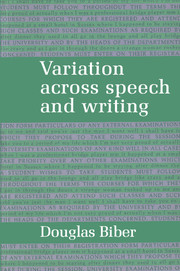Book contents
- Frontmatter
- Contents
- List of figures
- List of tables
- Acknowledgments
- Part I Background concepts and issues
- Part II Methodology
- 4 Methodological overview of the study
- 5 Statistical analysis
- Part III Dimensions and relations in English
- Appendix I Texts used in the study
- Appendix II Linguistic features: algorithms and functions
- Appendix III Mean frequency counts of all linguistic features in each genre
- Appendix IV Pearson correlation coefficients for all linguistic features
- References
- Index
4 - Methodological overview of the study
Published online by Cambridge University Press: 05 June 2012
- Frontmatter
- Contents
- List of figures
- List of tables
- Acknowledgments
- Part I Background concepts and issues
- Part II Methodology
- 4 Methodological overview of the study
- 5 Statistical analysis
- Part III Dimensions and relations in English
- Appendix I Texts used in the study
- Appendix II Linguistic features: algorithms and functions
- Appendix III Mean frequency counts of all linguistic features in each genre
- Appendix IV Pearson correlation coefficients for all linguistic features
- References
- Index
Summary
Macroscopic and microscopic approaches to textual variation
Within the broad framework of investigation into the psychological and sociological underpinnings of linguistic variation, researchers have investigated textual variation through macroscopic and microscopic analyses. Macroscopic analysis attempts to define the overall dimensions of variation in a language. Microscopic analysis, on the other hand, provides a detailed description of the communicative functions of particular linguistic features (e.g., clefts as markers of informational prominence, or first person pronouns as markers of personal involvement).
Much of the previous work analyzing linguistic variation in texts falls into the category of microscopic analysis. For instance, Schiffrin (1981) looks at the different functions of past tense and present tense forms in referring to past events in narrative. Aijmer (1986) and Stenström (1986) study the functions of actually and really respectively in conversational texts. Thompson (1983) studies the functions of detached participial clauses in descriptive texts. And Tannen (1982a) contrasts the level of imageability in written and spoken narratives to illustrate the use of oral strategies in written discourse. These and other studies are characterized by their detailed attention to the functions of specific features in representative texts.
Macroscopic analyses identify the overall parameters of linguistic variation within a given ‘domain’, e.g., spoken and written texts in English or the range of expository prose in English; they are based on the notions of textual dimension and textual relation.
- Type
- Chapter
- Information
- Variation across Speech and Writing , pp. 61 - 78Publisher: Cambridge University PressPrint publication year: 1988

